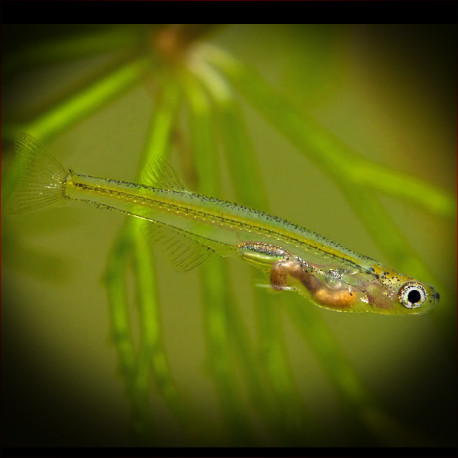More info
Datasheet
| Minimum Tank Size | 40 litres / 10.57 US gallons |
| Maximum Size | 1.7cm / 0.67inches |
| Temperature | 20°C / 68.00°F - 26°C / 78.80°F |
| Hardness | 18-90ppm. |
| pH | 6.5-7.5 |
General Description
Danionella Dracula, commonly known as Dracula fish, is a diminutive species belonging to the family Cyprinidae. It is recognized for its tiny adult size of 1.7cm and unique jaw morphology characterized by tooth-like odontoid processes.
Aquarium Setup
For optimal care, Danionella Dracula should be kept in a planted aquarium with gentle water movement. It is recommended to have vegetation covering a portion of the surface, along with clumps of Taxiphyllum to provide micro-organisms for both fry and adults to feed on. An air-powered sponge-type filter unit is ideal, and the water conditions should be maintained at a temperature of 20-26°C, pH of 6.5-7.5, and hardness of 18-90ppm (see table).
Behaviour
This species is best kept alone due to its diminutive size and the priority of breeding for its well-being. If considering a community tank, it is advisable to select small fishes like Celestichthys, Microdevario, or Boraras spp. Danionella Dracula is a schooling fish by nature, thriving best in a group of ideally no less than a dozen individuals.
Feeding and Diet
Being quite easily-fed, Danionella Dracula accepts various food types including crushed dried foods, chopped Tubifex, Artemia nauplii, microworm, and sifted Daphnia. To ensure optimal health, it is recommended to provide a varied diet to meet its nutritional requirements.
Reproduction & Dimorphism
Reproduction in captivity is not well-documented for Danionella Dracula. Some success has been reported with related species, where eggs are deposited onto the substrate in cone-shaped masses. Males exhibit enlarged mouth parts with tooth-like processes and fang-like projections, while females are deeper-bodied, often displaying visible eggs when gravid.
Habitat and Distribution
Danionella Dracula is native to the Mogaung Chaung in northern Myanmar, a tributary of the Ayeyarwady River. The species is likely confined to a small area within this region. Myanmar serves as a center of diversity for the genus, hosting at least four endemic species of Danionella.

